| |
|
Württemberg |  |
|
The first listed references to “Rothermel” we were able to find were in 1283 when a Conrad Rotermelli was reported as a resident of Freiburg (Freiburg in Breisgau) and in 1341 a Hans Rotärmeller was a resident of Weingarten in Switzerland. Prior to these, in 1209 a Theodor Rodarm (red arm) was recorded in Köln (Cologne on the Rhine), and he may very well have earned this as a nickname from his military service, and as a result it became his surname, which was later changed to Rodärmel (red sleeve) as was a more common derivation in the High Middle Ages along with surnames such as Weißärmel (white sleeve) and Blauärmel
(blue sleeve).
Almost all of the early records and evidence we found of Rothermels were in the Rhenish Palatinate within 25 miles around the city of Heidelberg. There were three towns in southern Hesse, Erbach, Biebesheim, and Rimbach, Hassloch in the Palatinate, and Rotenberg in Baden. Heidelberg is about 60 miles northwest of Ilshofen and Hörlebach in Württemberg.
Kehl Rothermel
President, Rothermel Family Association of Berks County
.......................................................................................................................
After carrying out extensive research for us ( UK Branch ) Daniel Stihler the Chief Archivist of the very famous Schwäbish Hall Archives is compiling our Rothermel Ancestor list as a new document .
.............................................................................................................................
Recently Margit Schulte Beerbhül of Düsseldorf University has done a study about the migration of families from Württemberg to England in the 18th and 19th centuries. Up until 1905 there were no immigration controls in England. Different from the emigrants to America who fled out of sheer poverty the early ones who settled in England were merchants, artists and crafstmen, many were butchers. there are very few documented records
but in the 1700 's approximately 2000 Germans lived in London.
by 1900 there were probably 9000.
In the middle of the 1800's around 100 pork butchers from Württemberg arrived in Liverpool and they prospered.
Margit worked in collaboration with Kingston University and also with Panikos Panayl of
De Monfort University who has written a book about the subject.
THE HAMBURGER
1758 - By the mid-18th century, German immigrants began arriving in England. One recipe, titled "Hamburgh Sausage," appeared in Hannah Glasse's 1758 English cookbook called The Art of Cookery Made Plain and Easy. It consisted of chopped beef, suet, and spices. The author recommended that this sausage be served with toasted bread. Hannah Glasse's cookbook was also very popular in Colonial America, although it was not published in the United States until 1805. This American edition also contained the "Hamburgh Sausage" recipe with slight revisions.
In 1802, the Oxford English Dictionary defined Hamburg steak as salt beef. It had little resemblance to the hamburger we know today. It was a hard slab of salted minced beef, often slightly smoked, mixed with onions and breadcrumbs. The emphasis was more on durability than taste.
1894 - In the 1894 edition of the book The Epicurean: A Complete Treatise of Analytical & Practical Studies, by Charles Ranhofer (1836-1899), chef at the famous Delmonico's restaurant in New York, there is a listing for Beef Steak Hamburg Style. The dish is also listed in French as Bifteck à Hambourgeoise. What made his version unique was that the recipe called for the ground beef to be mixed with kidney and bone marrow:
In the late eighteenth century, the largest ports in Europe were in Germany. Sailors who had visited the ports of Hamburg, Germany and New York, brought this food and term "Hamburg Steak" into popular usage. To attract German sailors, eating stands along the New York city harbour offered "steak cooked in the Hamburg style."
|
|
| |
| Article on Schwäbisch-Hall quality pork on pdf |
|
|
| |
| | The German pork butchers mostly came into the country via Hull, spread out from there and settled in the industrial towns and harbour towns of northern England like Sheffield, Bradford, Leeds, Manchester and later also Liverpool. A second principal focus was of course the British capital London. In the course of a growing market during the second half of the 19th century they also set up numerous shops in smaller villages. Robert Roberts writes:"By the outbreak of the first world war it is doubtful if there was a single Northern town, large or small, that did not have its German pork butchers." The Germans were absolute specialists in pork butchering.
1. Nearly the complete pork butcher market in the northern counties of England was in the hands of Hohenlohe emigrants.
2. These emigrants had managed to establish a close-knit family- and business network and hence enhanced chain migration from their home country, especially from the districts of Künzelsau, Schwäbisch Hall and Gerabronn.
3. The German immigrants knew each other well and recruited their personnel from relatives, neighbours and friends at home.
4. They knew the market in Great Britain and wherever a person, a journeyman, apprentice or servant was needed, they knew someone at home or they requested someone from their neighbourhood in their home country to fill the gap.
Many thanks to Karl-Heinz Wüstner |
|
Maps showing the area where most of the Pork Butchers came from | 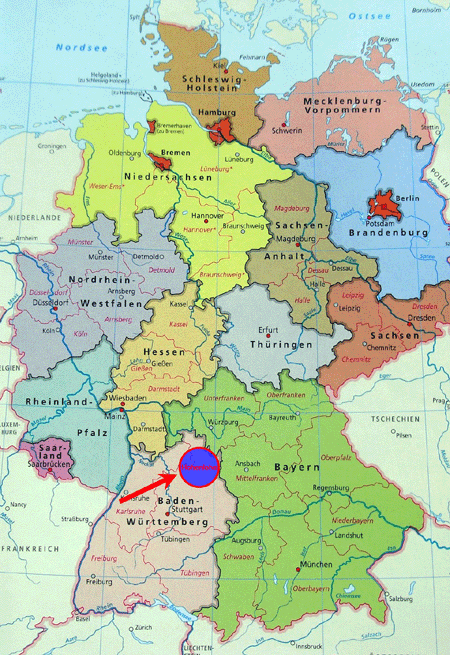 |
|
| |
| Images kindly donated by Karl-Heinz Wüstner - Ilshofen |
|
| |
|
The Museum in Stuttgart | 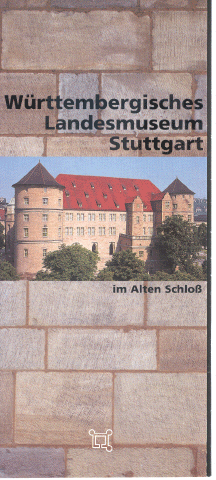 |
|
| | After World War 11 Württemberg and Baden were occupied by the USA and were joined into one state to become part of the Federal German Republic of Germany they merged officially on 25 April 1952. The principal city is Stuttgart. The Rhine forms the western border as well as large portions of the southern border. The Black Forest rises east of the Rhine valley. Baden-Württemberg shares both Lake Constance and the foothills of the Alps with Switzerland. The state houses some of the oldest and most prestigious universtities in Germany. In many areas of Baden-Würtemberg residents speak the distinctive dialects of Swabian (Schwäbisch), being almost unintelligible to northern Germans, especially in its stronger forms in the countryside. |
|
|
| |
| | Not only were Janice and Alastair (Watson) brought up with an abundance of stories about their Bird Childs and Goldsmith ancestry on their maternal side, it transpires the same thing happened on the paternal side as well. Also now we are in contact with other Rothermel cousins it appears the same thing happened in their families as well. We can only asume this was because of the very sensitive German issue in the 20th century. |
|
| |
|
Schwäbisch Hall 1643 - copperplate Matthaeus Merian | 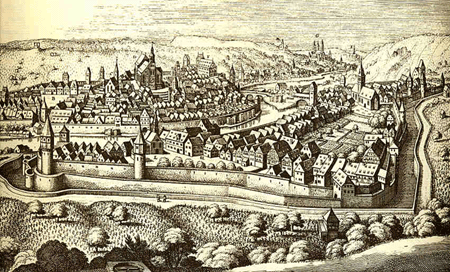 |
|
Swabia
A historical region of southwest Germany that originally included parts of present-day France and Switzerland. It was divided into small principalities and fiefdoms after 1268, but its prosperous towns often banded together in defensive leagues, most notably the Swabian League of 1488 to 1534.
See these webpages for the history of the area click for link
|
|
|
| | Meyers Gazetteer of the German Empire
Meyers Orts- und Verkehrs-Lexikon des Deutschen Reichs
This database contains Meyers Geographical and Commercial Gazetteer of the German Empire (or Meyers Orts- und Verkehrs-Lexikon des Deutschen Reichs in German). This gazetteer of the German Empire is the gazetteer to use to locate place names in German research. It was originally compiled in 1912. This gazetteer is the gazetteer to use because it includes all areas that were part of the pre-World War I (WWI) German Empire. Gazetteers published after WWI may not include parts of the Empire that were lost to bordering countries. Overall, this gazetteer includes more than 210,000 cities, town, hamlets, villages, etc.
|
|
| |
|
| | Dear Ms Carrera
Thanks for your email of 28 June
Sadly there are no references to the Rothermels in our general index to documents in the Record Office.
I also could not find them listed in the 1874 and 1877 trade directories for Northamptonshire. These are the only two we have between 1873 and 1881. George Rothermel appears in the 1886 directory at 12 High Street.
George Rothermel appears in the 1881 electoral register for Wellingborough. These are annual so it should be possible to trace him backwards to the register he first appears in. You would be welcome to visit the Record Office to see these, and the later trade directories but it is not possible to access the electoral registers online.
There are no Rothermels in the current Northamptonshire telephone directory.
I hope I have been of some assistance.
Yours sincerely
Crispin Powell
Archivist
..................................................................................................................
Since discovered in 2012
1876 Nothing not even under private residents
no 12 High Street was a Fishmongers owned by Henry Linnell (Bakers at no 14)
Henry Linnell moved to 36 Market Sreet then 200 Wellingborough Rd
1877 JGM married Noami Shaw ( not listed as butcher - perhaps worked for Meyer for a bit?)
1881 JGM Rothermel 12 High street Wellingborough Butcher
1881 John G Rothermel unmarried brother 12 High Street Wellingborough Butcher
1883 Georg Married Ellen Pendred Wellingborough
1888 birth of Rosina in Irthlingborough
1885 82 Wilford Road was a General Dealer and 84 a Baker and Confectioner ( Eastman's not listed)
1888 Georg was definitely in Irthlingborough ( re letter heading )
1889 birth of Fritz in Irthlingborough ( Master Butcher)
1890 they were both listed G Rothermel High Street Wellingborough Butcher,
J Rothermel Irthlingborough Butcher
1894 John Rothermel 54 Dame Agnes St Nottingham PORK BUTCHER
1898 G Rothermel 12 High Street Wellingborough Butcher
1898 Eastman's Ltd 82 Wilford Road Nottingham
1899 Michael died
1902/3 12 High Street sold to Joseph John Arthey
John Georg Rothermel
1901 Eastman's 82 Wilford Road
1905 Eastman's 82 Wilford Road
1909 Rosina married from 84 Wilford Road
1911 Eastman's 82 Wilford Road
1914 Eastman's 82 Wilford Road
1916 Eastman's 82 Wilford Road
1920 Died as Journeyman Butcher ( employee ) 134 Querneby Road Nottingham
Appears they arrived in 1876/7 ?
John Georg - Move to Irthlingborough after marriage to Ellen and birth of Rosina ?
Move to Nottingham early 1890's Listed as Pork Butcher under his own name only in 1894
from late 1890's worked for Eastman's at 82 Wilford Road
TC Eastman was a New Yorker. He shipped cattle to the UK. His main agent was John Bell of Glasgow. Eastman had 110 shops & in 1890 Bell joined Eastman to form Eastman’s Ltd, by now selling frozen meat. Eastman’s were taken over by Vestey Bros which then became the Dewhurst chain (dissolved 1995).
TC Eastman made the first successful shipment of chilled beef from New York to England in 1873
Dewhursts and Eastmans the Master Butchers, specialized in New Zealand lamb, Australian and Argentinean beef, Argentinean corned beef and home killed pork, mutton and cow Beef.
The Vestey managers were notoriously underpaid in salary, however as long as they turned in 33 % gross profit each week, they could pocket the rest. This made them extremely well paid, if they were good. |
|
12 High Street Wellingborough today |  |
|
| | it appears that after Johann Georg Michael died in 1899 Naomi continued in the business with her two sons Fritz as Butcher's Manager and George Carl as Butcher until around 1902/3
The business did not appear in the 1903 Kellys Directory but in the 1906 edition it was named Arthey and Son.
Joseph John Arthey was listed as a Farmer of 140 acres on the 1881 Census in Suffolk
In 1891 he was a Farmer employer of men
In 1901 he was a Farm Bailiff in Huntingdonshire
1911 Census trading as a butcher at 12 High Street Wellingborough
No 12 High Street continued in the Arthey name all through both world war years, as a Butchers. Joseph John died in 1933 aged 80 in Wellingborough. His son Frederick Benjamin continued in the business until 1958 when he retired. He died in 1969 in Wellingborough.
It was never listed as a Pork Butchers. |
|
|
| | This is the first time that the Rothermel brothers appeared on a UK Census, born in Germany but already British Subjects. Sadly younger brother Frederick Martin had died aged 21 of Peritonitis in 1878 at no 18 High Street Wellinghborough, home of the Shaws. |
|
UK Census 1881 |  |
|
|
| |
|
Rothermel Ancestry Schwäbisch Hall Germany | 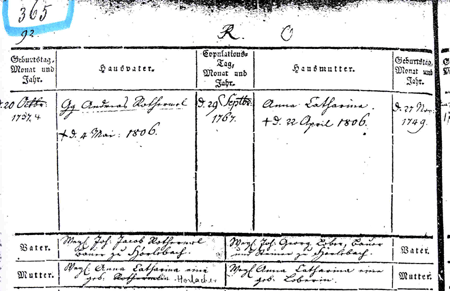 |
|
| |
| |
Individual birth registration 1852 - Johann Georg Michael | 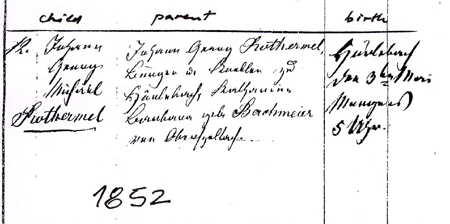 |
|
|
Click Download for Folker Frank's translation
|
|
|
|
| |
| | Julius Rothermel was born on 12.03.1909 at no 8 Dirkhill Street Horton Bradford. His mother Barbara Lena gave her address as 67 Rugby Place when she registered the birth six weeks later. There was no father or father's occupation on the certificate. The only name appearing under surname and maiden name of mother is Watson - Confidential Clerk.
We have no idea what Barbara Lena was doing in Bradford around the summer of 1909 when Julius was born. On the 1901 Census she was living at home in Wellingborough and working as a Drapers Assistant.
There were only five Watson families living in Wellingborough in 1901 all married any of them could have been a likely candidate as father. She may have become pregnant by one of them and was 'sent away' to have the baby. There were many living in Bradford mostly working in the Mills it seemed a fairly common name. However a Joshua Watson aged 61 years was living in Horton and was a Debt Collector. He had a wife Elizabeth and on tracing back the couple had never had children. Joshua moved from Grantham Road to Listerhills, very near to where Lena was living and Julius was born. Perhaps he was her employer? As a Debt Collector he possibly had a Confidential Clerk. There was a vast age difference between them of 44 years.
We have no idea what happened to Julius and where he was brought up, the only piece of information we have is that he attended Wellingborough Public School.
On 5th August 1916 Barbara Lena married Ernest Albert Butler in the Methodist Chapel Shardlow Long Eaton Derbyshire. The Butler family lived in Wellingborough just around the corner to Barbara Lena. A son Ernest Derek was born but he has been very difficult to trace.
We now have news that he was alive in 1998 and living in Preston Lancs where he was desperately trying to trace his family roots. He says he was brought up by his mother and grandmother after his parents separated.
Julius was very secretative about his upbringing, we were told many stories as children including an incorrect date of birth, resulting in 'major' birthdays such as 50th, 60th. etc being celebrated in the wrong year! There was always a 'hint' of German ancestry in several guarded answers to childhood questioning. The name Butler was never discussed and always remained a complete mystery. Julius was seven when Barbara Lena married Ernest Butler in Derbyshire, so must have known his stepfather.
Sadly Janice and Alastair had nothing to do with their grandmother or their father's half brother Derek whilst growing up due to a family fued never explained so she probably did not know that she had a great grand child Andrea. |
|
Wellingborough School | 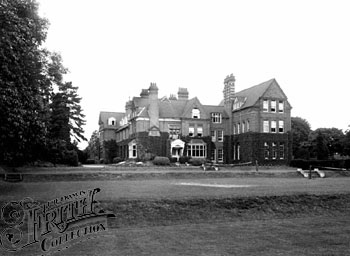 |
|
|
| | Translated by Folker Frank:
Else Ziegler is about 80 years old, but in good form. She told me something about her life in Hörlebach. In April 1945 the men of the Nazi SS fought very strongly in this region against the Americans who were based in the east. The Americans had first to go back. But returned a second time with great force and destroyed the nice town of Crailsheim and the village of Hörlebach! Half of Hörlebach was destroyed in April 1945, the northern part in the direction of Langenburg. Else was as a young girl (18-19) very strong, but hurt through a phosphorgranade, her legs were totally burnt, she was over 32 weeks in a hospital and is today a 75% a war invalide. But your Rothermel and her house were not destroyed in 1945. You really have had so much luck meeting Else Ziegler. She told me that the Rothermels went to “Ölhaus” = Oelhaus (the name is Ölhaus) 4 km south of Ilshofen. Oelhaus is not a village only 3-4 houses. Else recently had a birthday and there she heared that the family formerly called Rothermel in Ölhaus now has the name Hermann. I think there was at the end only a daughter called Rothermel and she married probably a Hermann. But all these Rothermels must be descended from Heinrich Rothermel, he was the only one left (in Germany) and the last son of Georg Rothermel, Heinrich (half-brother of your greatgrandfather Michael Rothermel) was also the only male Rothermel who lived in Hörlebach.
|
|
| |
|
1891 Census Wellingborough | 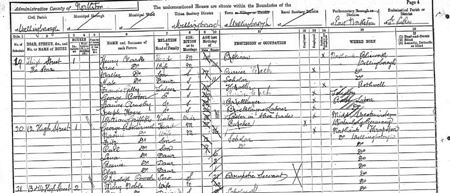 |
|
Brothers' Butchers shops listed 1890 |  |
|
1901 Census Wellingborough |  |
|
| Apologies for bad reproductions - contact us for clearer copies |
|
|
| | John George Michael and Naomi had five children
Fritz Martin
George Carl
Barbara Lena
Gretchen M
Olga Katherine
John George (brother) had three children
Regina
Fritz Pendred
Albert George (died at a few months old)
Fritz Martin never married (Frederick)
George Carl - Elizabeth Hargreaves 1912
Olga Katherine - Arthur Gardner
Barbara Lena - one illegitimate son (Julius 'Watson' b 1909) - Ernest Albert Butler 1916
Gretchen - FR Tilley
George and Lizzie were married 15 July 1912 at St George Church in Newcastle Under Lyme in Staffordshire. I haven''t got the original copy of their marriage but I do have all the information from it. Elizabeth Hargreaves age 28 living at 1 Foden Street - Father Charles deceased Time-keeper
George Carl Rothermel 29 living at 60 Broad Street Worcester, Butcher, Father George deceased Butcher
Witnesses William Bourne and Adelaide Maria Hargreaves.
- Information supplied by Wendy Hargreaves-
Fritz Martin (Frederick) of 5 Yew Tree Cottages The Driffold Sutton Coldfield Died 1955 and left £266.9.2 to his sister Olga Gardner
George Carl died Blackpool ?
Barbara Lena died Torquay 1976 aged 90
Albert George died 1894 (c 6mths old)
Rosina Regina Died 1955
Fritz Pendred died 1952
More research to be carried out on the family birth marriages and deaths |
|
|
Watson in Horton Bradford | 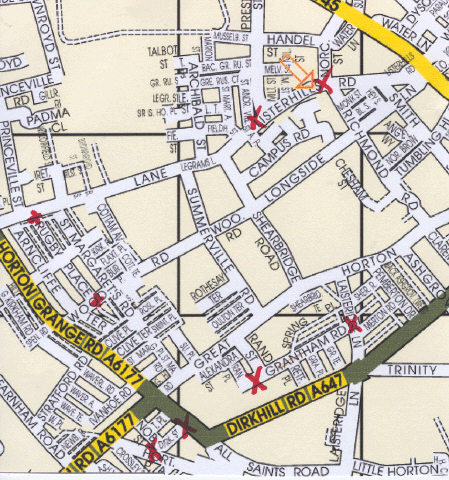 |
|
|
| |
| | Barbara Lena Rothermel had another son Derek whose surname was Butler. No one seemed to know who 'Mr Butler' was. She arrived with Derek alone in Torquay just before the second world war. Harry Bird initially provided them with accommodation in Esdaile. According to older family members there was never a 'Mr Butler' around, stories of him 'being in India'.
John Julius did not speak to his mother for around 30 years (cause never explained but a strange 'religion and sect and turning to Russia' was mentioned ) many secrets were kept. At her death in 1976 as a Barbara Lena Butler aged 91 yrs he received a letter from Derek who was living in Wales. She is described as the widow of Albert Ernest Butler - Journeyman Carpenter (retired)
|
|
John and Derek Grantham 1941 | 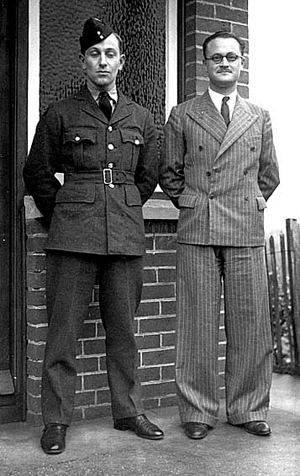 |
|
|
| Click 'Download pdf' to view Archives kindly translated by friend Folker Frank |
|
Schwäbisch Hall 1841 | 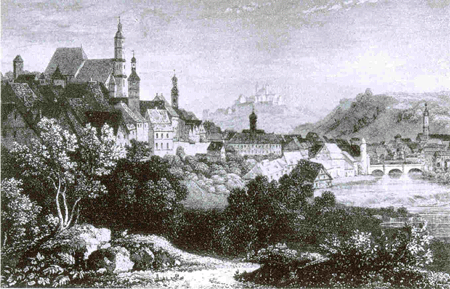 |
|
|
| |
| |